A Year of Action
A Year of Action
In his 2014 State of the Union address, President Obama promised that 2014 would be a year of action. Twelve months later, that's a promise kept.
This is what a year of action looks like:
More than 80 new executive actions to help grow the economy, create jobs, address the threat of climate change, and strengthen the middle class.
Rallying calls to action that have convened leaders from business, nonprofits, education, and the community — resulting in billions of dollars in pledges to expand opportunity for more Americans across the board.
A plan that offers 4 million undocumented immigrants a path out of the shadows, all the while holding them accountable.
This year, the President has supported workplace flexibility and equal pay. He's protected large swaths of federal lands and oceans from degradation. He's put in place historic changes that will dramatically cut greenhouse gas emissions down the road. He's expanded proven job-driven training models and helped make student loan payments more affordable.
Then, read on below for a summary of the major actions the President took this year, complete with shareable graphics and tweets to help spread the word.
MIDDLE CLASS SECURITY AND OPPORTUNITY AT WORK
Promoting Economic Development in "Promise Zones"
JANUARY 9: Early this year, the President announced the first five Promise Zones — regions that have put forward plans on how they'll partner with local businesses and community leaders to make investments that reward hard work and expand opportunity for more Americans. In return, these regions will receive the resources and flexibility they need to achieve their goals.
The first five Promise Zones are San Antonio, Philadelphia, Los Angeles, Southeastern Kentucky, and the Choctaw Nation of Oklahoma — part of the 20 that the will be announced over the next three years.
Helping Americans Retire with Dignity
JANUARY 29: The President directed the Treasury Department to create “myRA,” a new starter savings account that will help millions of Americans begin saving for their retirement. 
Raising the Minimum Wage
FEBRUARY 12: The President will raise the minimum wage for federal contractors to $10.10, because no one who works full-time should have to live in poverty. 
Strengthening Overtime Protections
MARCH 13: Every worker should be paid a fair wage equal to their efforts. That's why the President signed a Presidential Memorandum directing the Secretary of Labor to update overtime pay protections to help make sure millions of workers are paid a fair wage for a hard day's work — and that the rules are simplified for workers and employers alike.
Ensuring Equal Pay for Women
APRIL 8: Finding out whether or not you're earning fair pay at work starts with a conversation. That's why President Obama took executive action prohibiting federal contractors from retaliating against employees who choose to discuss their compensation. Further, the President signed a Presidential Memorandum instructing the Secretary of Labor to establish new rules requiring federal contractors to submit summary data on their employees' compensation to the Department of Labor — including data by sex and race. 
Building 21st-Century Workplaces
JUNE 23: The President announced a set of concrete steps to create more opportunity for hardworking families. He issued a Presidential Memorandum directing federal agencies to implement existing efforts to expand flexible workplace policies — from affordable child care to paid family leave — to the maximum possible extent, making clear that federal workers have a "right to request" a flexible work arrangement without fear of retaliation. And the Department of Labor is making funds available for technical skill training grants to give low-wage earners the opportunity to advance their careers in in-demand industries. $25 million of those funds will be focused on addressing barriers to training faced by those with child care responsibilities.
LGBT Executive Order
JULY 21: American workers should be judged by one thing only: their ability to get the job done. But millions of Americans in most states go to work every day fearing they will lose their jobs simply because of who they love. That's why, in July, the President signed an Executive Order prohibiting federal contractors from discriminating against LGBT employees and prohibiting discrimination based on gender identity in federal employment.
Keeping Our Workplaces Safe and Fair
JULY 31: The President signed an Executive Order cracking down on federal contractors who put workers’ safety and hard-earned pay at risk. It will require prospective federal contractors to disclose labor law violations and will give agencies more guidance on how to consider — and help remediate — labor violations when awarding federal contracts. That's because every year, tens of thousands of American workers are denied overtime wages, not hired, or not paid fairly because of their gender or age — or have their health and safety put at risk by corporations contracting with the federal government that cut corners. It's wrong, and we're fixing it.
Answering the Public's Call by Unlocking Cell Phones
AUGUST 1: President Obama signed the Unlocking Consumer Choice and Wireless Competition Act into law — a bill that once again made it legal for consumers to unlock their cell phones in order to take them to a carrier that best suits their needs. And here's what was special about this particular bill: It marked the very first time a We the People petition led to a legislative fix. In signing the bill, the President broke through Washington gridlock to restore the freedom of consumers to take their mobile phones wherever they choose. It was a win for the American people, and an important milestone for the We the People platform.
Acting to Improve Medicare
OCTOBER 6: President Obama signed an Executive Order to improve the quality of care of Medicare beneficiaries, including for nursing home and home health patients. The Improving Medicare Post Acute Care Transformation Act of 2014 (IMPACT Act) put in place streamlined quality and communication measures for nursing homes, home health agencies, and other health and hospice organizations participating in Medicare. The IMPACT Act expanded and strengthen Medicare’s widely used Five Star Quality Rating System for nursing homes and improved quality home health care by proposing rules that improved transparency and strengthened patient rights.
Protecting a Free and Open Internet
NOVEMBER 10: President Obama announced his plan to protect net neutrality and ensure that neither cable nor phone companies could act as gatekeepers to the internet. The President asked the FCC for rules that reflected common-sense steps people everywhere already observe online, including:
* No blocking. If a customer requests access to a website and the content is legal, your ISP should not be permitted to block it.
* No throttling. Your ISP should not be able to intentionally slow down some content or speed up others.
* Increased transparency. The connection between consumers and ISPs is not the only place some sites might get special treatment, so the President asked the FCC to make full use of the transparency authorities to apply net neutrality rules between the ISP and the rest of the internet.
Building Trust Between Communities and Local Law Enforcement
DECEMBER 1: Events in Ferguson, Missouri, in New York City, and in Cleveland this year revealed a deep distrust between a community and its police force. This is not just one community's issue — this is an American issue. That is why President Obama issued an Executive Order creating a task force on 21st century policing that will work with law enforcement and civil rights and civil liberties organizations to develop specific recommendations. He also took action to advance the use of body-worn cameras, promote proven community policing initiatives, expand the community-oriented policing model, and reform how the federal government equips state and local law enforcement, particularly with military-style equipment.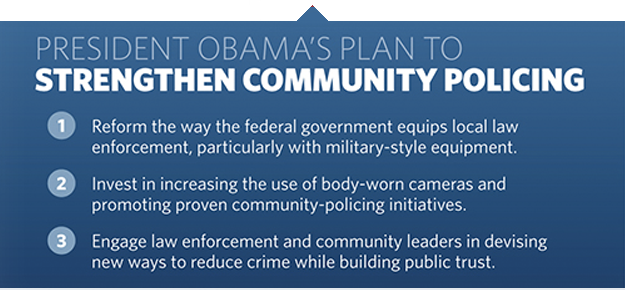
President Obama will continue calling on Congress to:
1: Raise the minimum wage to $10.10 for all American workers.
2: Ensure women get equal pay for equal work by passing paycheck fairness
3: Extend emergency unemployment insurance for Americans who are looking for work.
4: Reward hard work by expanding the Earned Income Tax Credit.
5: Remove retirement tax breaks for the wealthiest Americans and improve them for the middle class.
6: Protect LGBT workers by passing the Employment Non-Discrimination Act.
JOBS AND ECONOMIC OPPORTUNITY
Fixing Our Broken Immigration System
NOVEMBER 20: President Obama used his executive authority to take important steps in fixing our broken immigration system. He acted within his authority to crack down on illegal immigration at the border, prioritize deporting felons not families, and require certain undocumented immigrants to pass a criminal background check and pay their fair share of taxes as they register to temporarily stay in the U.S. without fear of deportation. These actions will hold nearly 5 million undocumented immigrants accountable while increasing our real GDP by $90 billion to $210 billion in 2024. 
Investing in High-Tech Manufacturing
In January and February, the President announced three more high-tech manufacturing institutes — next-generation power electronics in Raleigh, digital manufacturing and design in Chicago, and lightweight and modern metals in the Detroit area — and there are at least four more on the way. These institutes bring together companies, universities and community colleges, and government to co-invest in the development of world-leading manufacturing technologies and capabilities that U.S.-based manufacturers can apply in production. 
Spurring Innovation in Manufacturing
DECEMBER 11: The President fulfilled his State of the Union pledge to launch four more manufacturing innovation hub competitions this year. The competitions feature institutes that are focused on improving efficiency through smart manufacturing, integrated photonics, advanced composites, and hybrid flexible electronics.
Learn more about these competitions.
Training America's Workers
JANUARY 30: President Obama directed the Vice President to lead a full review of the federal job-training system to ensure job-training programs are demand-driven, high-quality, and lead to well-paying jobs. And on April 16, the President and Vice President announced two new grant programs to spread models of job-driven training — along with private-sector commitments to build on those efforts.
SEPTEMBER 29: The Administration announced the final round of Trade Adjustment Assistance Community College and Career Training (TAACCCT) grants, marking an investment of more than $1 billion in awards to roughly 700 community colleges nationwide since 2011. These grants help community colleges develop and expand curriculum with the needs of businesses, so students can move right into ready-to-be filled jobs in their communities.
Learn more about how these job-training grants are helping to change lives.
Helping the Long-Term Unemployed
JANUARY 31: The President is partnering with CEOs and other business leaders to get long-term unemployed Americans back to work. More than 300 companies have already signed onto new best practices for recruiting and hiring the long-term unemployed. 
Streamlining Export-Import Processes
FEBRUARY 19: The President signed an Executive Order requiring the completion of the International Trade Data System by December 2016, which will help businesses more easily transmit the data required by the U.S. government to import or export cargo. This will cut processing and approval times from days to minutes for businesses, especially small businesses, that export American-made goods and services.
Strengthening Travel and Tourism
MAY 22: President Obama set a goal to bring 100 million visitors to the U.S. each year, up from the 70 million annual tourists the U.S. sees today. That's why he directed the U.S. Department of Homeland Security and Department of Commerce to develop a national goal for improving the entry process and reduce wait times for international travelers visiting the U.S., and action plans at the 15 largest airports for international arrivals.
Supporting Making and Manufacturing Entrepreneurship
JUNE 18: At a visit to a TechShop event in Pittsburgh — and in conjunction with the first-ever White House Maker Faire — President Obama announced a new federal initiative to help makers launch new businesses and create jobs, as well as new commitments from the Department of Education and five other agencies to create more Makerspaces, enlist more educators in teaching Making, and expanding access to tools and mentors generally.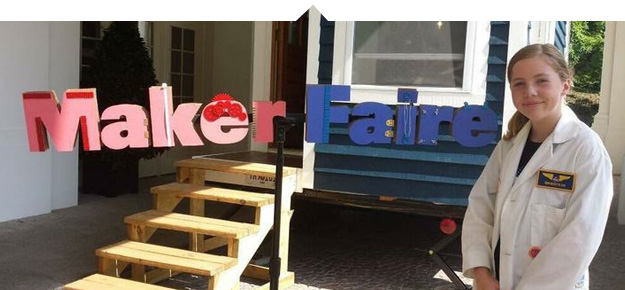
Modernizing Infrastructure
SEPTEMBER 9: The Administration is taking bold action to ensure America has first-class transportation infrastructure. The Infrastructure Investment Summit, held at the Treasury Department on September 9, brought together investors that planned to deploy more than $50 billion in U.S. infrastructure. A series of investments and commitments were also announced at the Summit, including:
* A $950 million loan for the Orlando, Florida I-4 Ultimate highway project from the U.S. Department of Transportation, the largest loan ever completed for a public-private partnership from the TIFIA program
* $518 million in loans for electricity infrastructure from the U.S. Department of Agriculture
* The creation of a new partnership for infrastructure innovation by the Ford Foundation and Rockefeller Foundation
DOT's TIGER Grants
SEPTEMBER 12: The Administration also announced the sixth round of the Department of Transportation’s TIGER program. The new round made nearly $600 million in TIGER grants available, awarding them to 72 transportation projects across 46 states and D.C.
Reining in Corporate Tax Inversions
SEPTEMBER 22: The Treasury Department announced that it would take steps to discourage companies from taking advantage of corporate tax inversions. An inversion is a type of corporate tax deal wherein a U.S.-based multinational with operations in other countries moves the tax residence of the parent company overseas — moving into a low-tax jurisdiction to avoid paying U.S. taxes.
Get more details about inversions here.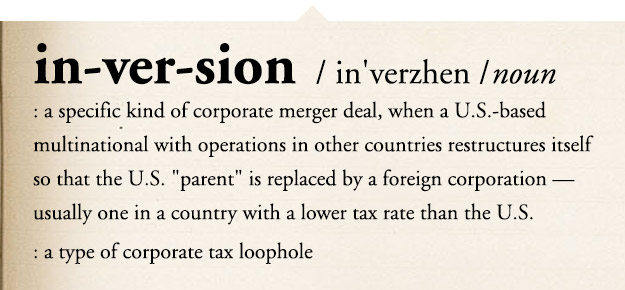
President Obama will continue calling on Congress to:
1: Reform business taxes and end tax breaks for companies that ship jobs overseas.
2: Fix America’s broken immigration system.
3: Invest in economic growth while continuing to strengthen America’s long-term fiscal position.
4: Open new markets for American-made products.
5: Support America’s job creators through a small business and entrepreneurship agenda.
6: Expand fuel choices for American drivers.
ENERGY AND ENVIRONMENT
Increasing Fuel Efficiency
FEBRUARY 18: The President directed the Environmental Protection Agency and Department of Transportation to develop and issue the next phase of fuel-efficiency standards for heavy-duty vehicles and to propose new incentives for medium- and heavy-duty trucks that run on alternative fuels like natural gas — benefiting our planet, our economy, and our energy security. 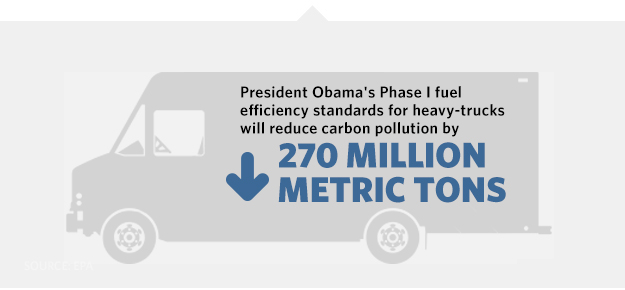
Increasing Solar Deployment
SEPTEMBER 18: As part of the Administration’s efforts to fight climate change, the White House announced a series of public and private-sector commitments and executive actions to advance solar deployment and promote energy efficiency.
The announcements made on September 18 will cut carbon pollution by nearly 300 million metric tons through 2030 – equivalent to taking more than 60 million cars off the road for one year – and will save homes and businesses more than $10 billion on their energy bills. When combined with the commitments President Obama announced in May, they represent more than 350 private and public sector commitments to deploy 885 megawatts of solar and improve the energy efficiency of more than 1.4 billion square feet of buildings.
Preserving the Outdoors
MARCH 11: In his State of the Union address, President Obama pledged to use his authority to protect more of our pristine federal lands for future generations. On March 11, he signed a proclamation to protect the Point Arena-Stornetta Public Lands, a 1,665-acre stretch of northern California's coastline. On May 21, he established the Organ Mountains-Desert Peaks National Monument in south central New Mexico, which could generate $7.4 million in new economic activity each year. The President then issued a memorandum on June 20 directing federal agencies to take steps to protect and restore domestic populations of pollinators — critical contributors of more than $24 billion to our economy that are essential to our food system and environmental health.
OCTOBER 10: The President signed an executive order establishing the San Gabriel Mountains as a national monument. President Obama’s proclamation permanently protected 346,177 acres of national forest land in southern California, increasing access and outdoor opportunities for adventure seekers and preserving the area for generations to come.
DECEMBER 16: To cap off 2014, President Obama designated the pristine waters of Alaska’s Bristol Bay as off limits to consideration for oil and gas leasing. The action safeguards one of the nation’s most productive fisheries and preserves an ecologically rich area of the Bering Sea that is vital to Alaska’s commercial fishing and tourism economy and to Alaska Native communities.
Learn more about why the President took action to protect Bristol Bay. 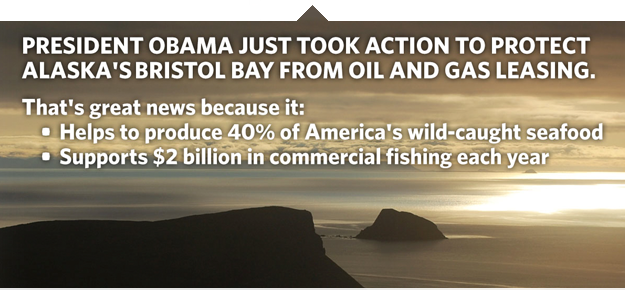
Preparing for Climate Change
MAY 6: President Obama has announced a series of executive actions to reduce carbon pollution, prepare the U.S. for the impacts of climate change, and lead international efforts to address global climate change. On May 6, the Administration released the third U.S. National Climate Assessment — the most authoritative and comprehensive source of scientific information to date about climate-change impacts across the U.S. The report made clear that climate change isn't a distant threat — it's affecting us now.
At the 2014 U.N. Climate Summit, President Obama announced an executive order on Climate-Resilient International Development, requiring agencies to factor climate-resilience considerations systematically into the U.S. government’s international development work and to promote a similar approach across the world.
In October, federal agencies released plans for reducing their greenhouse gas emission and preparing for climate change impacts such as flooding, sea level rise, severe weather, and temperature extremes.
And, in November President Obama announced the U.S.’ intention to contribute $3 billion to the Green Climate Fund (GCF) to reduce carbon pollution and strengthen resilience in developing countries. 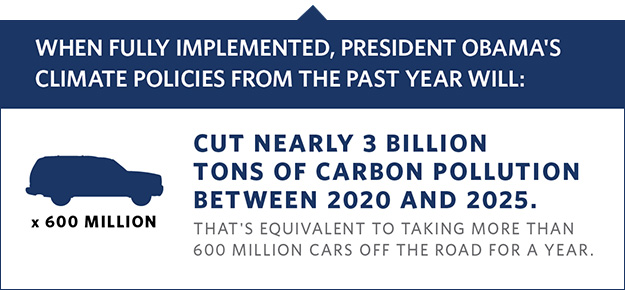
Cutting Domestic Carbon Pollution
JUNE 2: The Environmental Protection Agency released the Clean Power Plan — proposed carbon pollution standards for existing power plants that will protect the health of our children and put our nation on the path toward a 30 percent reduction in carbon pollution from the power sector by 2030. The proposal will lead to climate and health benefits worth an estimated $55 billion to $93 billion in 2030, including avoiding 2,700 to 6,600 premature deaths and 140,000 to 150,000 asthma attacks in children.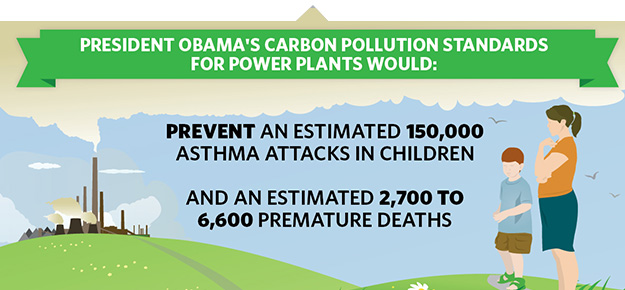
Reducing the World’s Carbon Footprint
NOVEMBER 11: During a trip to Beijing, President Obama laid out an ambitious but achievable target to reduce greenhouse gas emissions around the world. In a historic joint announcement with China, President Obama announced that the U.S. had set a new target for reducing emissions in the range of 26-28 percent by 2025. Simultaneously, China announced its intent to increase the share of non-fossil fuels in primary energy consumption to around 20 percent. The new U.S. goal is predicted to double the pace of carbon pollution reduction from 1.2 percent per year on average during the 2005-2020 period to 2.3-2.8 percent per year on average.
Reducing HFC Emissions
SEPTEMBER 16: The Administration announced new private-sector commitments and executive actions to reduce emissions of hydrofluorocarbons (HFCs), powerful greenhouse gases that contribute to climate change. The commitments made would reduce cumulative global consumption of these greenhouse gases by the equivalent of 700 million metric tons of carbon dioxide through 2025, equivalent to 1.5% of the world’s 2010 greenhouse gas emissions and the same as taking nearly 15 million cars off the road for 10 years.
Learn more about how the U.S. is leading the charge to reduce these pollutants.
Protecting Our Oceans
SEPTEMBER 25: President Obama signed a proclamation to designate the largest marine reserve in the world that is completely off-limits to commercial resource extraction. The proclamation expanded the existing Pacific Remote Islands Marine National Monument in the south-central Pacific Ocean to six times its size, resulting in 490,000 square miles of protected area around these tropical islands and atolls.
The Administration is also taking steps to protect coastal communities from the impacts of climate change, improve domestic aquaculture, and provide research to better understand the challenges facing our oceans.
Educational Opportunity
Increasing College Opportunity
JANUARY 16: The President is asking colleges, universities, nonprofits, and businesses to develop ways to improve students’ access to and completion of higher education, because a college education is a prerequisite for 21st-century jobs.
AUGUST 13: Over the course of the past year, hundreds of colleges, universities, and organizations from across the country have stepped up to the President and the First Lady's call to action with new commitments to expand college opportunity for low-income students.
DECEMBER 4: The White House hosted the first two College Opportunity Summits, engaging more than 100 college presidents to make over 600 commitments to improve success in college completion, K-16 partnerships, STEM graduates, and college counseling. 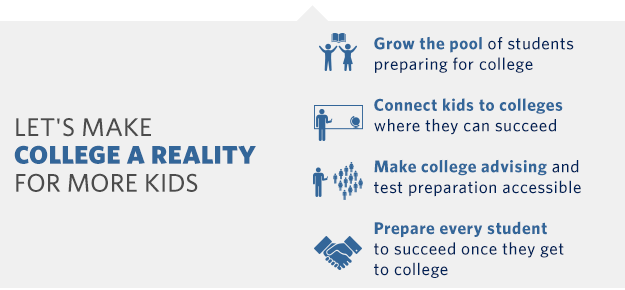
Digital Learning for Students
FEBRUARY 4: President Obama’s ConnectED initiative, which is designed to enrich K-12 education for all students through digital technology, has catalyzed $2 billion in private-sector commitments of tablets, laptops, software, teacher training, and wireless connectivity. The President announced the first wave of commitments in February, and now students in all 50 states are taking advantage of these free resources.
NOVEMBER 19: More than 1,200 district superintendents across the United States committed over 16,000 schools under their leadership to transform in line with the ConnectED vision. All 1,200 superintendents signed the Future Ready Digital Pledge as part of the President’s ConnectED initiative, committing to empower teachers with the best technology and training to make the most of student learning, and committing to connect students with greater access to broadband internet. These superintendents represent approximately 10 million students in all 50 states.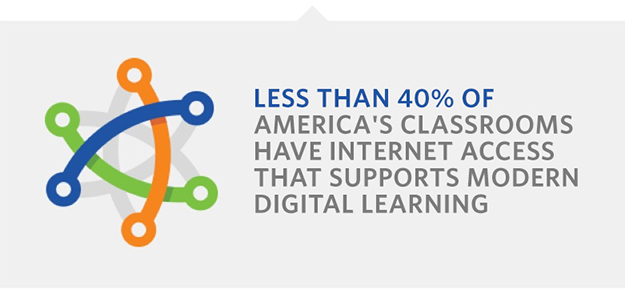
Connecting Students to Broadband
DECEMBER 11: The FCC voted to significantly expand the funding available under the E-rate program for schools and libraries to upgrade their broadband connectivity. This builds on the $2 billion in previously announced E-rate support for WiFi connectivity, which itself will connect 20 million more students to high-speed WiFi. This puts us squarely on the path to achieve the President’s goal of connecting 99% of students to high-speed broadband by 2018. The connectivity will empower America’s students through personalized learning and rich, digital content.
Creating Opportunity for Boys and Young Men of Color
FEBRUARY 27: The President signed a Presidential Memorandum establishing the My Brother's Keeper Task Force to assess which public and private efforts are improving life outcomes for boys and young men of color, and how the federal government's policies and programs can better support those efforts.
JULY 21: More than $300 million in commitments have been announced to support My Brother's Keeper's work so far, with nearly 200 communities accepting the MBK Community Challenge. Significant progress has been made on the task force's recommendations. 
Help More Students Apply for Federal Aid for College
MARCH 7: The President announced a FAFSA Completion Initiative, led by the Department of Education, to increase the percentage of students who complete the Free Application for Federal Student Aid form (FAFSA). Federal student aid provides more than $150 billion in federal grants, loans, and work-study funds each year to more than 15 million students paying for college or career school — and almost everyone is eligible for some type of financial aid. 
Redesigning Our High Schools
APRIL 7: President Obama announced more than $100 million in grants — using existing Department of Labor funds — to support high school models that better prepare students for college and the careers of the future. This is part of the President's broader challenges to high schools to scale up innovative models that will redesign and personalize teaching and learning for students, in order to teach these students the skills they will need in college and beyond.
Helping More Girls and Boys Succeed in Science, Technology, Engineering, and Math (STEM
May 27: As part of the fourth-ever White House Science Fair, the President announced new steps to help more students excel in STEM subjects — including a new $35 million teacher training competition, in support of the President's goal to train 100,000 excellent STEM teachers. Other key steps include a major expansion of STEM AmeriCorps to provide STEM learning opportunities for 18,000 low-income students this summer, and a national US202-led STEM mentoring effort in seven cities. 
Making College More Affordable
JUNE 9: To make sure student loans remain affordable for all federal direct loan borrowers, the President directed the Secretary of Education to allow all students to cap their payments at 10 percent of their monthly incomes. That new plan will be available to borrowers by December 2015. The Administration is also taking additional steps to help students repay their loans, including providing relief to service members, and renegotiating contracts with federal loan servicers to strengthen incentives that help borrowers repay their loans on time.
Investing in Early Childhood Education
DECEMBER 10: The President is committed to supporting the education of young children, starting at birth. He convened state and local policymakers, educators, and community leaders at an Early Education Summit at the White House who pledged to spur greater access to high-quality preschool and early learning. Together with federal grants, this marked a collective investment of more than $1 billion in the education of America's youngest learners.
President Obama will continue calling on Congress to:
1: Make high-quality preschool available to all American children.
2: Transform America’s high schools to ensure students are college and career ready.
Thank You
For your submission
A Year of Action
In his 2014 State of the Union address, President Obama promised that 2014 would be a year of action. Twelve months later, that's a promise kept.
This is what a year of action looks like:
More than 80 new executive actions to help grow the economy, create jobs, address the threat of climate change, and strengthen the middle class.
Rallying calls to action that have convened leaders from business, nonprofits, education, and the community — resulting in billions of dollars in pledges to expand opportunity for more Americans across the board.
A plan that offers 4 million undocumented immigrants a path out of the shadows, all the while holding them accountable.
This year, the President has supported workplace flexibility and equal pay. He's protected large swaths of federal lands and oceans from degradation. He's put in place historic changes that will dramatically cut greenhouse gas emissions down the road. He's expanded proven job-driven training models and helped make student loan payments more affordable.
Then, read on below for a summary of the major actions the President took this year, complete with shareable graphics and tweets to help spread the word.
MIDDLE CLASS SECURITY AND OPPORTUNITY AT WORK
Promoting Economic Development in "Promise Zones"
JANUARY 9: Early this year, the President announced the first five Promise Zones — regions that have put forward plans on how they'll partner with local businesses and community leaders to make investments that reward hard work and expand opportunity for more Americans. In return, these regions will receive the resources and flexibility they need to achieve their goals.
The first five Promise Zones are San Antonio, Philadelphia, Los Angeles, Southeastern Kentucky, and the Choctaw Nation of Oklahoma — part of the 20 that the will be announced over the next three years.
Helping Americans Retire with Dignity
JANUARY 29: The President directed the Treasury Department to create “myRA,” a new starter savings account that will help millions of Americans begin saving for their retirement. 
Raising the Minimum Wage
FEBRUARY 12: The President will raise the minimum wage for federal contractors to $10.10, because no one who works full-time should have to live in poverty. 
Strengthening Overtime Protections
MARCH 13: Every worker should be paid a fair wage equal to their efforts. That's why the President signed a Presidential Memorandum directing the Secretary of Labor to update overtime pay protections to help make sure millions of workers are paid a fair wage for a hard day's work — and that the rules are simplified for workers and employers alike.
Ensuring Equal Pay for Women
APRIL 8: Finding out whether or not you're earning fair pay at work starts with a conversation. That's why President Obama took executive action prohibiting federal contractors from retaliating against employees who choose to discuss their compensation. Further, the President signed a Presidential Memorandum instructing the Secretary of Labor to establish new rules requiring federal contractors to submit summary data on their employees' compensation to the Department of Labor — including data by sex and race. 
Building 21st-Century Workplaces
JUNE 23: The President announced a set of concrete steps to create more opportunity for hardworking families. He issued a Presidential Memorandum directing federal agencies to implement existing efforts to expand flexible workplace policies — from affordable child care to paid family leave — to the maximum possible extent, making clear that federal workers have a "right to request" a flexible work arrangement without fear of retaliation. And the Department of Labor is making funds available for technical skill training grants to give low-wage earners the opportunity to advance their careers in in-demand industries. $25 million of those funds will be focused on addressing barriers to training faced by those with child care responsibilities.
LGBT Executive Order
JULY 21: American workers should be judged by one thing only: their ability to get the job done. But millions of Americans in most states go to work every day fearing they will lose their jobs simply because of who they love. That's why, in July, the President signed an Executive Order prohibiting federal contractors from discriminating against LGBT employees and prohibiting discrimination based on gender identity in federal employment.
Keeping Our Workplaces Safe and Fair
JULY 31: The President signed an Executive Order cracking down on federal contractors who put workers’ safety and hard-earned pay at risk. It will require prospective federal contractors to disclose labor law violations and will give agencies more guidance on how to consider — and help remediate — labor violations when awarding federal contracts. That's because every year, tens of thousands of American workers are denied overtime wages, not hired, or not paid fairly because of their gender or age — or have their health and safety put at risk by corporations contracting with the federal government that cut corners. It's wrong, and we're fixing it.
Answering the Public's Call by Unlocking Cell Phones
AUGUST 1: President Obama signed the Unlocking Consumer Choice and Wireless Competition Act into law — a bill that once again made it legal for consumers to unlock their cell phones in order to take them to a carrier that best suits their needs. And here's what was special about this particular bill: It marked the very first time a We the People petition led to a legislative fix. In signing the bill, the President broke through Washington gridlock to restore the freedom of consumers to take their mobile phones wherever they choose. It was a win for the American people, and an important milestone for the We the People platform.
Acting to Improve Medicare
OCTOBER 6: President Obama signed an Executive Order to improve the quality of care of Medicare beneficiaries, including for nursing home and home health patients. The Improving Medicare Post Acute Care Transformation Act of 2014 (IMPACT Act) put in place streamlined quality and communication measures for nursing homes, home health agencies, and other health and hospice organizations participating in Medicare. The IMPACT Act expanded and strengthen Medicare’s widely used Five Star Quality Rating System for nursing homes and improved quality home health care by proposing rules that improved transparency and strengthened patient rights.
Protecting a Free and Open Internet
NOVEMBER 10: President Obama announced his plan to protect net neutrality and ensure that neither cable nor phone companies could act as gatekeepers to the internet. The President asked the FCC for rules that reflected common-sense steps people everywhere already observe online, including:
* No blocking. If a customer requests access to a website and the content is legal, your ISP should not be permitted to block it.
* No throttling. Your ISP should not be able to intentionally slow down some content or speed up others.
* Increased transparency. The connection between consumers and ISPs is not the only place some sites might get special treatment, so the President asked the FCC to make full use of the transparency authorities to apply net neutrality rules between the ISP and the rest of the internet.
Building Trust Between Communities and Local Law Enforcement
DECEMBER 1: Events in Ferguson, Missouri, in New York City, and in Cleveland this year revealed a deep distrust between a community and its police force. This is not just one community's issue — this is an American issue. That is why President Obama issued an Executive Order creating a task force on 21st century policing that will work with law enforcement and civil rights and civil liberties organizations to develop specific recommendations. He also took action to advance the use of body-worn cameras, promote proven community policing initiatives, expand the community-oriented policing model, and reform how the federal government equips state and local law enforcement, particularly with military-style equipment.
President Obama will continue calling on Congress to:
1: Raise the minimum wage to $10.10 for all American workers.
2: Ensure women get equal pay for equal work by passing paycheck fairness
3: Extend emergency unemployment insurance for Americans who are looking for work.
4: Reward hard work by expanding the Earned Income Tax Credit.
5: Remove retirement tax breaks for the wealthiest Americans and improve them for the middle class.
6: Protect LGBT workers by passing the Employment Non-Discrimination Act.
JOBS AND ECONOMIC OPPORTUNITY
Fixing Our Broken Immigration System
NOVEMBER 20: President Obama used his executive authority to take important steps in fixing our broken immigration system. He acted within his authority to crack down on illegal immigration at the border, prioritize deporting felons not families, and require certain undocumented immigrants to pass a criminal background check and pay their fair share of taxes as they register to temporarily stay in the U.S. without fear of deportation. These actions will hold nearly 5 million undocumented immigrants accountable while increasing our real GDP by $90 billion to $210 billion in 2024. 
Investing in High-Tech Manufacturing
In January and February, the President announced three more high-tech manufacturing institutes — next-generation power electronics in Raleigh, digital manufacturing and design in Chicago, and lightweight and modern metals in the Detroit area — and there are at least four more on the way. These institutes bring together companies, universities and community colleges, and government to co-invest in the development of world-leading manufacturing technologies and capabilities that U.S.-based manufacturers can apply in production. 
Spurring Innovation in Manufacturing
DECEMBER 11: The President fulfilled his State of the Union pledge to launch four more manufacturing innovation hub competitions this year. The competitions feature institutes that are focused on improving efficiency through smart manufacturing, integrated photonics, advanced composites, and hybrid flexible electronics.
Learn more about these competitions.
Training America's Workers
JANUARY 30: President Obama directed the Vice President to lead a full review of the federal job-training system to ensure job-training programs are demand-driven, high-quality, and lead to well-paying jobs. And on April 16, the President and Vice President announced two new grant programs to spread models of job-driven training — along with private-sector commitments to build on those efforts.
SEPTEMBER 29: The Administration announced the final round of Trade Adjustment Assistance Community College and Career Training (TAACCCT) grants, marking an investment of more than $1 billion in awards to roughly 700 community colleges nationwide since 2011. These grants help community colleges develop and expand curriculum with the needs of businesses, so students can move right into ready-to-be filled jobs in their communities.
Learn more about how these job-training grants are helping to change lives.
Helping the Long-Term Unemployed
JANUARY 31: The President is partnering with CEOs and other business leaders to get long-term unemployed Americans back to work. More than 300 companies have already signed onto new best practices for recruiting and hiring the long-term unemployed. 
Streamlining Export-Import Processes
FEBRUARY 19: The President signed an Executive Order requiring the completion of the International Trade Data System by December 2016, which will help businesses more easily transmit the data required by the U.S. government to import or export cargo. This will cut processing and approval times from days to minutes for businesses, especially small businesses, that export American-made goods and services.
Strengthening Travel and Tourism
MAY 22: President Obama set a goal to bring 100 million visitors to the U.S. each year, up from the 70 million annual tourists the U.S. sees today. That's why he directed the U.S. Department of Homeland Security and Department of Commerce to develop a national goal for improving the entry process and reduce wait times for international travelers visiting the U.S., and action plans at the 15 largest airports for international arrivals.
Supporting Making and Manufacturing Entrepreneurship
JUNE 18: At a visit to a TechShop event in Pittsburgh — and in conjunction with the first-ever White House Maker Faire — President Obama announced a new federal initiative to help makers launch new businesses and create jobs, as well as new commitments from the Department of Education and five other agencies to create more Makerspaces, enlist more educators in teaching Making, and expanding access to tools and mentors generally.
Modernizing Infrastructure
SEPTEMBER 9: The Administration is taking bold action to ensure America has first-class transportation infrastructure. The Infrastructure Investment Summit, held at the Treasury Department on September 9, brought together investors that planned to deploy more than $50 billion in U.S. infrastructure. A series of investments and commitments were also announced at the Summit, including:
* A $950 million loan for the Orlando, Florida I-4 Ultimate highway project from the U.S. Department of Transportation, the largest loan ever completed for a public-private partnership from the TIFIA program
* $518 million in loans for electricity infrastructure from the U.S. Department of Agriculture
* The creation of a new partnership for infrastructure innovation by the Ford Foundation and Rockefeller Foundation
DOT's TIGER Grants
SEPTEMBER 12: The Administration also announced the sixth round of the Department of Transportation’s TIGER program. The new round made nearly $600 million in TIGER grants available, awarding them to 72 transportation projects across 46 states and D.C.
Reining in Corporate Tax Inversions
SEPTEMBER 22: The Treasury Department announced that it would take steps to discourage companies from taking advantage of corporate tax inversions. An inversion is a type of corporate tax deal wherein a U.S.-based multinational with operations in other countries moves the tax residence of the parent company overseas — moving into a low-tax jurisdiction to avoid paying U.S. taxes.
Get more details about inversions here.
President Obama will continue calling on Congress to:
1: Reform business taxes and end tax breaks for companies that ship jobs overseas.
2: Fix America’s broken immigration system.
3: Invest in economic growth while continuing to strengthen America’s long-term fiscal position.
4: Open new markets for American-made products.
5: Support America’s job creators through a small business and entrepreneurship agenda.
6: Expand fuel choices for American drivers.
ENERGY AND ENVIRONMENT
Increasing Fuel Efficiency
FEBRUARY 18: The President directed the Environmental Protection Agency and Department of Transportation to develop and issue the next phase of fuel-efficiency standards for heavy-duty vehicles and to propose new incentives for medium- and heavy-duty trucks that run on alternative fuels like natural gas — benefiting our planet, our economy, and our energy security. 
Increasing Solar Deployment
SEPTEMBER 18: As part of the Administration’s efforts to fight climate change, the White House announced a series of public and private-sector commitments and executive actions to advance solar deployment and promote energy efficiency.
The announcements made on September 18 will cut carbon pollution by nearly 300 million metric tons through 2030 – equivalent to taking more than 60 million cars off the road for one year – and will save homes and businesses more than $10 billion on their energy bills. When combined with the commitments President Obama announced in May, they represent more than 350 private and public sector commitments to deploy 885 megawatts of solar and improve the energy efficiency of more than 1.4 billion square feet of buildings.
Preserving the Outdoors
MARCH 11: In his State of the Union address, President Obama pledged to use his authority to protect more of our pristine federal lands for future generations. On March 11, he signed a proclamation to protect the Point Arena-Stornetta Public Lands, a 1,665-acre stretch of northern California's coastline. On May 21, he established the Organ Mountains-Desert Peaks National Monument in south central New Mexico, which could generate $7.4 million in new economic activity each year. The President then issued a memorandum on June 20 directing federal agencies to take steps to protect and restore domestic populations of pollinators — critical contributors of more than $24 billion to our economy that are essential to our food system and environmental health.
OCTOBER 10: The President signed an executive order establishing the San Gabriel Mountains as a national monument. President Obama’s proclamation permanently protected 346,177 acres of national forest land in southern California, increasing access and outdoor opportunities for adventure seekers and preserving the area for generations to come.
DECEMBER 16: To cap off 2014, President Obama designated the pristine waters of Alaska’s Bristol Bay as off limits to consideration for oil and gas leasing. The action safeguards one of the nation’s most productive fisheries and preserves an ecologically rich area of the Bering Sea that is vital to Alaska’s commercial fishing and tourism economy and to Alaska Native communities.
Learn more about why the President took action to protect Bristol Bay. 
Preparing for Climate Change
MAY 6: President Obama has announced a series of executive actions to reduce carbon pollution, prepare the U.S. for the impacts of climate change, and lead international efforts to address global climate change. On May 6, the Administration released the third U.S. National Climate Assessment — the most authoritative and comprehensive source of scientific information to date about climate-change impacts across the U.S. The report made clear that climate change isn't a distant threat — it's affecting us now.
At the 2014 U.N. Climate Summit, President Obama announced an executive order on Climate-Resilient International Development, requiring agencies to factor climate-resilience considerations systematically into the U.S. government’s international development work and to promote a similar approach across the world.
In October, federal agencies released plans for reducing their greenhouse gas emission and preparing for climate change impacts such as flooding, sea level rise, severe weather, and temperature extremes.
And, in November President Obama announced the U.S.’ intention to contribute $3 billion to the Green Climate Fund (GCF) to reduce carbon pollution and strengthen resilience in developing countries. 
Cutting Domestic Carbon Pollution
JUNE 2: The Environmental Protection Agency released the Clean Power Plan — proposed carbon pollution standards for existing power plants that will protect the health of our children and put our nation on the path toward a 30 percent reduction in carbon pollution from the power sector by 2030. The proposal will lead to climate and health benefits worth an estimated $55 billion to $93 billion in 2030, including avoiding 2,700 to 6,600 premature deaths and 140,000 to 150,000 asthma attacks in children.
Reducing the World’s Carbon Footprint
NOVEMBER 11: During a trip to Beijing, President Obama laid out an ambitious but achievable target to reduce greenhouse gas emissions around the world. In a historic joint announcement with China, President Obama announced that the U.S. had set a new target for reducing emissions in the range of 26-28 percent by 2025. Simultaneously, China announced its intent to increase the share of non-fossil fuels in primary energy consumption to around 20 percent. The new U.S. goal is predicted to double the pace of carbon pollution reduction from 1.2 percent per year on average during the 2005-2020 period to 2.3-2.8 percent per year on average.
Reducing HFC Emissions
SEPTEMBER 16: The Administration announced new private-sector commitments and executive actions to reduce emissions of hydrofluorocarbons (HFCs), powerful greenhouse gases that contribute to climate change. The commitments made would reduce cumulative global consumption of these greenhouse gases by the equivalent of 700 million metric tons of carbon dioxide through 2025, equivalent to 1.5% of the world’s 2010 greenhouse gas emissions and the same as taking nearly 15 million cars off the road for 10 years.
Learn more about how the U.S. is leading the charge to reduce these pollutants.
Protecting Our Oceans
SEPTEMBER 25: President Obama signed a proclamation to designate the largest marine reserve in the world that is completely off-limits to commercial resource extraction. The proclamation expanded the existing Pacific Remote Islands Marine National Monument in the south-central Pacific Ocean to six times its size, resulting in 490,000 square miles of protected area around these tropical islands and atolls.
The Administration is also taking steps to protect coastal communities from the impacts of climate change, improve domestic aquaculture, and provide research to better understand the challenges facing our oceans.
Educational Opportunity
Increasing College Opportunity
JANUARY 16: The President is asking colleges, universities, nonprofits, and businesses to develop ways to improve students’ access to and completion of higher education, because a college education is a prerequisite for 21st-century jobs.
AUGUST 13: Over the course of the past year, hundreds of colleges, universities, and organizations from across the country have stepped up to the President and the First Lady's call to action with new commitments to expand college opportunity for low-income students.
DECEMBER 4: The White House hosted the first two College Opportunity Summits, engaging more than 100 college presidents to make over 600 commitments to improve success in college completion, K-16 partnerships, STEM graduates, and college counseling. 
Digital Learning for Students
FEBRUARY 4: President Obama’s ConnectED initiative, which is designed to enrich K-12 education for all students through digital technology, has catalyzed $2 billion in private-sector commitments of tablets, laptops, software, teacher training, and wireless connectivity. The President announced the first wave of commitments in February, and now students in all 50 states are taking advantage of these free resources.
NOVEMBER 19: More than 1,200 district superintendents across the United States committed over 16,000 schools under their leadership to transform in line with the ConnectED vision. All 1,200 superintendents signed the Future Ready Digital Pledge as part of the President’s ConnectED initiative, committing to empower teachers with the best technology and training to make the most of student learning, and committing to connect students with greater access to broadband internet. These superintendents represent approximately 10 million students in all 50 states.
Connecting Students to Broadband
DECEMBER 11: The FCC voted to significantly expand the funding available under the E-rate program for schools and libraries to upgrade their broadband connectivity. This builds on the $2 billion in previously announced E-rate support for WiFi connectivity, which itself will connect 20 million more students to high-speed WiFi. This puts us squarely on the path to achieve the President’s goal of connecting 99% of students to high-speed broadband by 2018. The connectivity will empower America’s students through personalized learning and rich, digital content.
Creating Opportunity for Boys and Young Men of Color
FEBRUARY 27: The President signed a Presidential Memorandum establishing the My Brother's Keeper Task Force to assess which public and private efforts are improving life outcomes for boys and young men of color, and how the federal government's policies and programs can better support those efforts.
JULY 21: More than $300 million in commitments have been announced to support My Brother's Keeper's work so far, with nearly 200 communities accepting the MBK Community Challenge. Significant progress has been made on the task force's recommendations. 
Help More Students Apply for Federal Aid for College
MARCH 7: The President announced a FAFSA Completion Initiative, led by the Department of Education, to increase the percentage of students who complete the Free Application for Federal Student Aid form (FAFSA). Federal student aid provides more than $150 billion in federal grants, loans, and work-study funds each year to more than 15 million students paying for college or career school — and almost everyone is eligible for some type of financial aid. 
Redesigning Our High Schools
APRIL 7: President Obama announced more than $100 million in grants — using existing Department of Labor funds — to support high school models that better prepare students for college and the careers of the future. This is part of the President's broader challenges to high schools to scale up innovative models that will redesign and personalize teaching and learning for students, in order to teach these students the skills they will need in college and beyond.
Helping More Girls and Boys Succeed in Science, Technology, Engineering, and Math (STEM
May 27: As part of the fourth-ever White House Science Fair, the President announced new steps to help more students excel in STEM subjects — including a new $35 million teacher training competition, in support of the President's goal to train 100,000 excellent STEM teachers. Other key steps include a major expansion of STEM AmeriCorps to provide STEM learning opportunities for 18,000 low-income students this summer, and a national US202-led STEM mentoring effort in seven cities. 
Making College More Affordable
JUNE 9: To make sure student loans remain affordable for all federal direct loan borrowers, the President directed the Secretary of Education to allow all students to cap their payments at 10 percent of their monthly incomes. That new plan will be available to borrowers by December 2015. The Administration is also taking additional steps to help students repay their loans, including providing relief to service members, and renegotiating contracts with federal loan servicers to strengthen incentives that help borrowers repay their loans on time.
Investing in Early Childhood Education
DECEMBER 10: The President is committed to supporting the education of young children, starting at birth. He convened state and local policymakers, educators, and community leaders at an Early Education Summit at the White House who pledged to spur greater access to high-quality preschool and early learning. Together with federal grants, this marked a collective investment of more than $1 billion in the education of America's youngest learners.
President Obama will continue calling on Congress to:
1: Make high-quality preschool available to all American children.
2: Transform America’s high schools to ensure students are college and career ready.
Thank You
For your submission